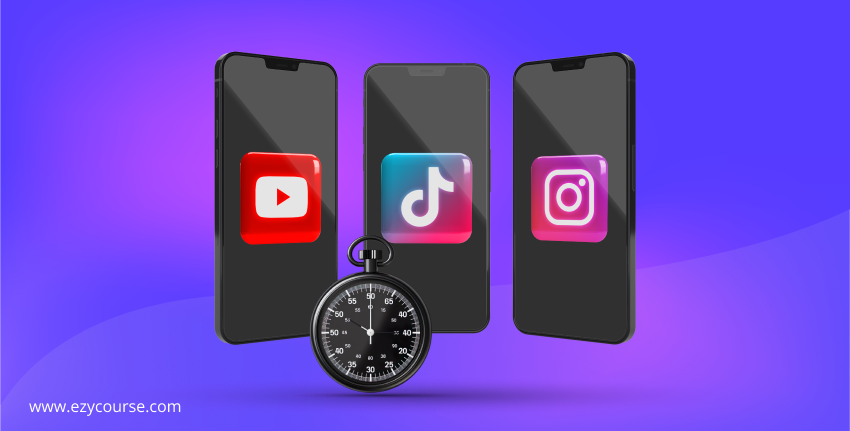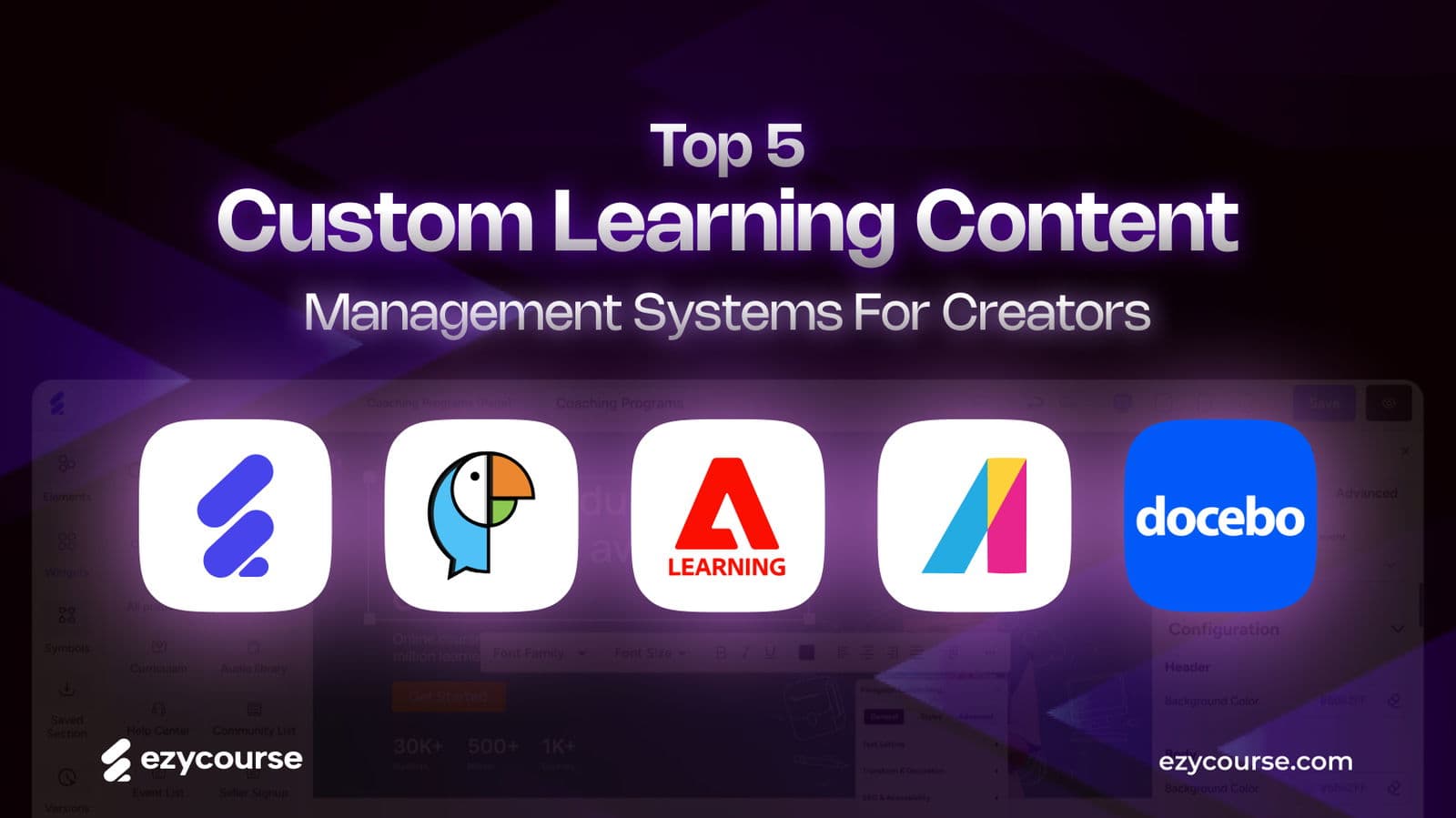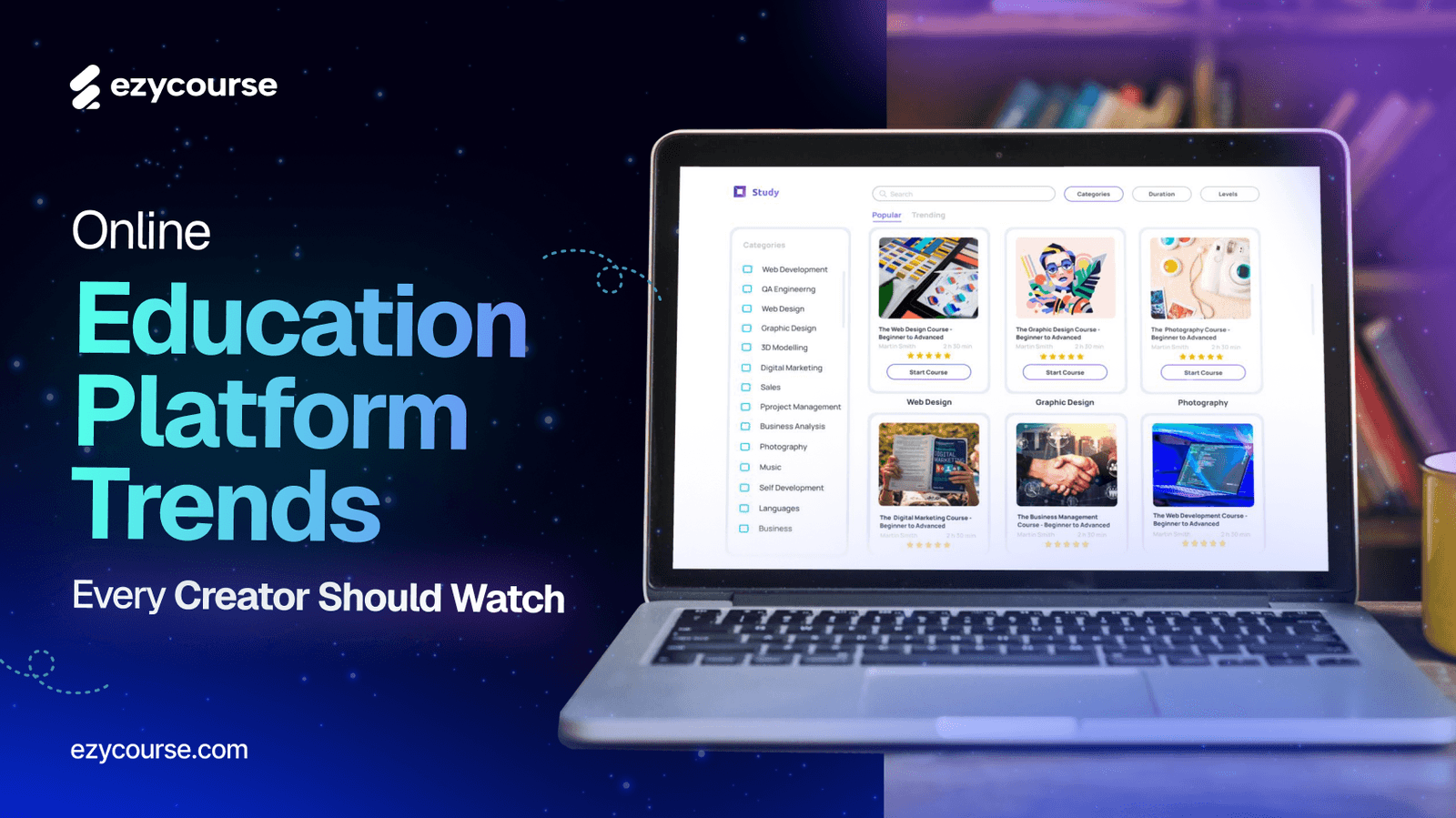Does short form video content convert users, or are we just scrolling our way into nothing? With TikTok, Instagram, and YouTube, it seems like everyone is trying their best to make short videos.
We think YOU’re no exception, right?
But do these fast, fun online videos really turn viewers into potential customers?
The truth is, that short videos can convert users into customers, but only if you do it right. Many people don’t get it right and end up with videos that don’t even connect.
That’s why today, we're going to help you understand how to make your short-form videos really work, get viewer’s attention, and turn most of them into customers with our simple steps.
If you skip reading this whole guide, you might miss some key tips.
What are Long and Short Form Videos?

Short form vs long form video content is just different types of videos mostly based on their length. Let’s first start by talking about short-form video content.
You might already know this. However, short-form videos are quick clips that last less than a minute. Yes, they are the short videos you see on Facebook or Instagram Reels.
They’re everywhere because they grab our attention fast.
Many marketers think the best length for a short-form video is between 31 and 60 seconds.
On the other hand, long-form videos are longer videos. They can last from a few minutes to over an hour. These include videos like YouTube tutorials or documentaries.
Do you know what’s interesting about long-form video marketing content? You can easily repurpose it into shorter clips.
So, now you know what short-form and long-form content are. But did you know there are lots of different kinds of each? If not, there is nothing to worry about! Let’s jump straight into the different types of short-form video content now.
Types of Short-Form Video Content
It might sound surprising, but Short-form videos come in many types, and we often don’t even notice them. Most of the time, we just watch them for fun.
But knowing the content types is important because you're not just here to learn what they are. You're here to figure out what's working, which ones are worth your time, and how to get the most out of them. We're not wrong, right?
If so, let us tell you there are more than 25 types of short-form video content. We won't go through all of them because that would just overwhelm you. Instead, we've grouped some similar types together and will focus on the most important and popular ones that people love.
Here are the different types of short-form video content:
Educational Short-Form Video Content

83% of people prefer watching videos to learn or get information. Every day, learning videos on YouTube get around 500 million views. Plus, 70% of marketers find educational videos very effective.
Do we still need to explain why educational short-form video content can be your most valuable asset for turning viewers into users?
However, educational short-form videos provide quick and easy-to-understand information. They show you how to do something or explain a concept in a short time by explainer videos. For example, there are tutorial videos like how to create & sell courses online with EzyCourse.
Inspirational Short-Form Video Content

Have you ever stopped scrolling because a motivational video caught your eye?
Like Martin Luther King Jr.'s 'I Have a Dream' or Nelson Mandela's 'I Am Prepared to Die.'
These videos inspire us. They often feature motivational quotes, success stories, or tips to boost confidence and drive.
There are over 198.1 million posts of motivational TikTok videos. Can you feel the excitement now? Yes, these are timeless videos that work anytime.
Entertaining Short-Form Video Content

The first two types of short-form videos we talked about are for learning and inspiration. But entertaining videos are a whole different ball game. These are the videos that make your users laugh, smile, or just have a good time.
They’re made to entertain and grab your attention.
For example, viral dance challenges, funny pet videos, or crazy stunts you see on TikTok 90-second videos or Instagram stories.
Now you might wonder, can you actually convert users with entertaining content? Look, converting viewers is definitely challenging, but it’s possible if you follow a few key steps which we will talk about later.
However, the success of this often comes down to the "reach" of your short-form content. And nothing beats entertaining content when it comes to getting maximum reach.
Personal Short-Form Video Content
Let’s focus on personal short-form videos. These videos are budget-friendly and easy to create. Research shows that people quickly judge trustworthiness. Videos that are honest and authentic can build more trust.
Personal short-form video content focuses on you, your experiences, and your unique personality. It’s all about sharing who you are and creating a real connection with your target audience.
Here’s a fun fact: 81% of people want interactive video content from brands. This number goes up to an impressive 94% for Gen Z, 90% for millennials, and 87% for high earners. (Source: Idomoo)
So, does that mean we should use personal short-form video content more and more to convert users and attract new leads?
We think yes, we should.
However, the benefits of each type will really surprise you. Ready to see for yourself? Let’s get in!
Benefits of Using Short-Form Video Content
81% of marketers revealed that video has directly helped increase sales. The sad thing is, that many video content creators struggle a lot to grab viewer’s attention in a short amount of time. In fact, most of us keep posting videos, but we all know how hard it is to really get people's attention.
That’s where short-form video content is most helpful and highly effective. And that’s not the only benefit. What else? Let’s find those out below:
Higher engagement rates: Want your videos to get more attention and interaction? Short-form videos are great for that. They get 2.5 times more engagement compared to longer videos. And guess what? 26% of marketers are planning to spend more on short-form content in 2024.
Easy to create videos quickly: Short-form videos don’t take hours to make. There are tons of ideas out there already. Just grab your camera and record something in under a minute.
Easy to Share: Because these videos are quick and fun, people are more likely to share them. Almost half of marketers (44%) already use short-form videos because they’re easy to share.
Better reach on social platforms: TikTok users, Instagram Reels viewers, and YouTube audiences, all love short videos. These platforms push short videos because users really like them. Experts think these will make up 90% of internet traffic by 2024.
Perfect for mobile users: Smartphone users are expected to grow by 1.7 billion from 2024 to 2029. If you’re not using short-form videos yet, you might be missing out!
Increases brand awareness: Increasing brand awareness is now easier with short-form videos. These videos are super shareable, as we mentioned earlier. Most brands are already jumping on this trend. Just check out your favorite brands. We are pretty sure that they’re posting tons of reels and short videos.
Great for testing content ideas: Short-form videos are perfect for testing new ideas quickly. You can see what works without wasting time or money. If it works, keep going. If not, just move on.
It’s now clear why short-form video is so popular. But one question might still bother you, why so many benefits? To really understand, you need to look at the psychology behind it.
Psychology Behind Short-Form Video Engagement

Our brains like things that catch our attention fast, especially if they’re interesting or important to us.
Short-form videos offer exactly that. They make our brains happy with small, easy-to-understand content. Our brains like new things, and short-form videos hit that sweet spot.
They give you something fresh without requiring much time. This fast gratification makes you more likely to stop, watch, and even share it with others.
So, is this the only thing behind short-form video content engagement? Oh no, this isn’t the only one, but it's definitely a big part. Now let's try to understand a few more key reasons why short-form videos keep viewers hooked:
Emotional Connection: Short videos often make us feel things like happiness, sadness, or excitement. Videos that make us feel strong emotions get shared twice as much. Our brains are drawn to things that make us feel, and these videos do that fast.
Simplicity: Short video content gets right to the point. If you enjoy watching short videos like us, you know this is true. There’s no extra information to distract us. This helps our brains understand things quickly and keeps us watching.
Repetition and Familiarity: When we see similar videos over and over, our brains start to recognize them. This familiarity makes us feel comfortable and more likely to watch. Our brains like repeating things because it feels safe and predictable, so we watch longer and might join in.
Social Proof: If a video has lots of likes, shares, or views, we think we should watch it too. This is called social proof. When we see others enjoying content that provides instant gratification, it makes us want to be part of that group (let’s be honest, you do the same). So we keep watching and engaging with the videos.
Social Media Knows Us: Ever feel like social media can read your mind? Well, it’s not magic, it’s just the algorithm. It’s really good at learning what we like to watch. The more we interact with certain types of videos, the more the platform shows us similar content.
Does Short Form Video Content Convert Users | Easy Steps To Convert Users?

We’ve talked a lot about this and that, but we’re not done yet! We’re here to answer your big question: Does shortform video content convert users?
We’ve already said yes, but we haven’t explained how. Sorry for keeping you waiting, but now the wait is over. We’re going to show you the exact steps that will convert viewers into customers and improve audience engagement, or whatever else you need them to be.
However, for your better understanding, we’ve simplified the steps into three important parts. So, here are the simple steps below:
Part 1: Planning the Video

If we really want to convert users, then the first step should be taken during the planning of your video, rather than while creating it. Most people make mistakes right here and end up just getting views on their short-form content, which was supposed to convert users.
Know Your Audience: Before we start, we first need to understand our audience and identify our ideal target for this video.
Finding the answers to these two questions can help us with our next process. In fact, this is helpful for finding content ideas too.
Pick a Clear Goal: Now, it's your time to answer a question: What do you want people to do after watching your video? We want to convert them, but into what?
Should they buy something? Sign up? Follow you? Decide on your goal before you even start creating the video. We hope this won’t be too hard for you.
Make a Simple Plan: Now it's time to start planning our video content. Remember, content is what makes the difference. Any single mistake can really make you pay badly, like wasting your time and ending up with little to no views. And engagement? Come on, it's not that easy.
So, you need to write down what you’ll say and show in the video. It doesn’t need to be super detailed, just enough for a 30-to-50-second video format so you know what you’re doing.
This reminds us of Social Searcher, a free but powerful tool to find out what's trending on multiple social platforms. Here's an example result of our search term "Online Learning Course."
Part 2: Creating the Video

Well, we did the first part right and properly. Now, here comes the second part. This one is just as important as the first one. Because people won’t see how we planned for it, but they will see the short-form content.
Grab Attention Fast: You only have 15 seconds to get people’s attention, so make it count. It could be a cool fact, a question, or a funny act. Make it something that will hook them right away.
Get to the Point: We're talking about short-form video content strategy here. This means we’re bound to a time limit of 15 to 60 seconds. No way can we say, “Hey, welcome to my channel,” or any bla bla. We really need to get to the point.
Start by saying exactly what you're offering in this video. In this case, you could use ChatGPT as your free assistant.
Show, Don’t Just Tell: Do you think people are scrolling through social media just to listen to some random person talk? Probably not. Let’s be real, people love watching the action. If you're talking about a product, show how it works. If it’s a story, act it out or use eye-catching visuals to keep them engaged.
End with a Call-to-Action: We’ve already picked our goal before creating the content, so we know what our call-to-action should be. But you need to end in a way that makes people take action after hearing it. Create curiosity, develop the fear of missing out, and encourage them to act.
Part 3: Publishing the Content

Here comes our final part. Even if we did the first two parts really well, we need to be mindful here too.
Pick the Right Platform: It’s obvious, but it’s not like you’ll get results right after publishing your content. You need to pick a platform where you’re hopeful of getting the most reach. Understand where your video subject is more popular.
Do your research. Ask yourself: Where is your audience hanging out? Are they TikTok users, Instagram users, or YouTube Shorts viewers? Choose short-form video platforms that fit your broader audience best.
Post at the Right Time: You want people to see your video, right? If so, then post it when most of your audience is online, so it gets the most views. Is it hard for you to figure out? Don’t worry, here are the best times to post on different social media platforms.
Use a Good Caption: The title or caption of your video matters. Keep it fun and simple, something that makes people curious.
Check the Short Form Video Statistics: After posting, see how your video is doing. Are people watching the whole thing? Do they like or share it?
If not, think about what you can change next time. Stats will help you improve your next short-form video. Eventually, you’ll start converting your users just by following these steps.
So, we believe each of the steps mentioned here is really crucial for your success. We’ve tried to cover everything while answering whether short-form video content converts users or not.
We hope this is a complete guide for Short-Form Video Content Marketing Strategies, but wait, there’s still a lot more to learn.
Platforms That Maximize Short-Form Video Output
Remember how we talked about picking the right platform? It’s really crucial.
Experts have found that content doesn’t do well on every platform. For example, your video might go viral on Facebook, but that same video might not even get 100 views on Instagram or YouTube. That’s why we need to wisely choose the platforms where our short videos will perform the best.
That’s why we need to pick the platforms where our short videos will do the best. Don’t worry, we’ve already figured it out for you! Here are the top 3 platforms for getting the most out of your short-form videos:
YouTube Shorts

YouTube Shorts are a big deal right now. Every day, over 70 billion views go to these short videos. That’s a ton! The way it works is pretty smart too. It’s important to learn how to use short form video in digital marketing.
YouTube looks at what people like and what they watch to show them more videos they’d enjoy. YouTube Shorts are growing fast and already have over 1.5 billion people watching every month. That means if you want your short video to be seen, YouTube is a goldmine, especially if you're into influencer marketing.
Facebook Reels

Facebook Reels is another great place for short videos. The cool part is you don’t need a huge following to make your videos popular. Sometimes, videos go viral, and you won’t even know why!
This is one example, where a page with only 600 followers got thousands of likes on a reel. It shows that even small creators can have big wins with Facebook Reels.
TikTok Short Videos

Do you know TikTok is one of the most engaging places to share short videos? Let’s look at the stats: People spend around 52 minutes a day on the app, so there are plenty of chances for your video to be seen.
And videos under 10 seconds get about 19 thousand views. That means TikTok is super powerful for grabbing attention fast and keeping people engaged. So, you might be 100% clear now about where to post your shorts.

Let's now clarify what to post.
5 Short Form Video Trends of 2025
Now the only obstacle that will come your way in terms of short-form video trends is what to post, what’s trending, and the viral topics. We know it well, so here are 5 short-form video content ideas you can follow and start posting from today.
User-Generated Content
More brands and creators are letting their audience take the stage. It’s simple, people TRUST other people. If viewers see someone like them using a product or sharing an experience, they’re more likely to engage. This trend is growing because it feels real and extremely relatable.
Behind The Scenes
Behind-the-scenes content is when you show what happens off-camera or before something is made. Will we be wrong if we say you love seeing the real, unrefined side of things because it feels more personal and enjoyable? So, never take these types of videos lightly. For example, if you’re making a product, you can show how it’s made, or introduce the team behind it.
AI-Generated Content
The global AI video generator market is expected to grow at a rate of 19.9% from 2024 to 2030. How fascinating is that? Are you really willing to miss out on using AI for short video production and waste tons of time doing everything manually?
Short Product Teaser
Got a new product? Show it off with a quick, engaging teaser. Instead of long ads, short-form videos give viewers just a taste of what’s coming. This keeps them curious and ready for more. It’s the perfect way to build excitement before a big release.
Evergreen Short Videos
These are videos that stay relevant no matter when people watch them. Tips, hacks, inspiring quotes, etc are some examples of evergreen short videos. These contents continue to provide value over time. Since they don’t lose their appeal, these videos are a smart way to keep getting views long after they’re posted.
Did We Succeed in Helping You Understand: Does Short Form Video Content Convert Users?
You made it to the end, and now you know: Does short form video content convert users or not? As the answer is yes, now you can confidently explain to others why it works. You’re the genius here now!
If we look at the first line of our article, we can confidently say we’ve covered everything from A to Z. So, tell us why you wouldn’t be an expert on this topic. However, if there’s anything you didn’t understand or think we should elaborate on, let us know with a quick comment.
Frequently Asked Questions
Do you have more questions in your head? Keep reading the section to know more.
When to Use Short-Form vs. Long-Form Video Content?
Use short-form content (15-60 seconds) when you want to grab attention quickly, entertain, or give a quick message. Long-form content (over 1 minute) is suitable for explaining something in more detail.
Is it a Bad Thing to Do Both Long-Form and Short-Form Content?
Not at all! Short-form video content can grab attention quickly, while long-form video content can provide in-depth information. So, combining both can be a smart video marketing strategy.
Is YouTube Shorts Worth It?
Absolutely! YouTube Shorts help creators test topics quickly and analyze results to improve long-form content. Shorts generally attract more views and likes than regular videos.
What Are the Tools to Use for Short-Form Video Creation?
Some useful tools for creating short-form videos include InShot, Canva, CapCut, and EzyCourse for publishing your video courses and other content.
How Do Marketers and Influencers Use Short-Form Content?
Marketers and influencers use short-form videos to grab attention fast. They make short clips to show off products and connect with people. These videos help build their brand and keep viewers interested. Also, they use short-form videos to keep their pages active by publishing posts regularly.






